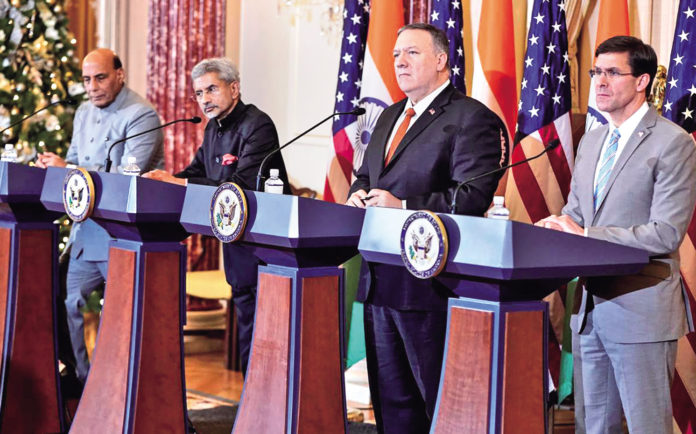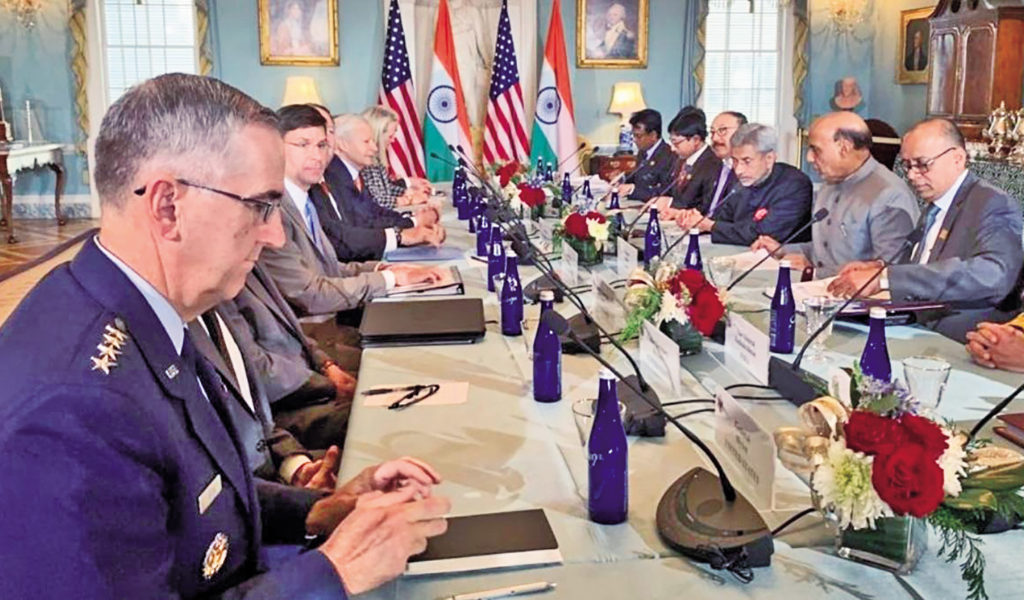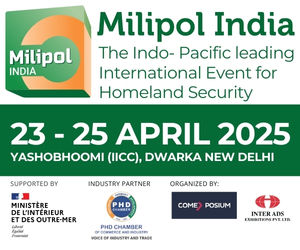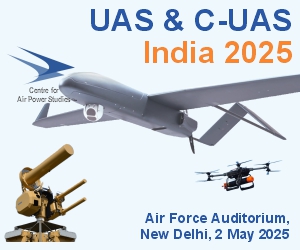
The second India-US 2+2 dialogue was held between US secretary of state Mike Pompeo, defense secretary Mark Esper and external affairs minister S Jaishankar and defence minister Rajnath Singh at the US State Department, Washington, on 18 December. Both sides reviewed ongoing cooperation in all areas of the interface of foreign policy and defence and outlined new priorities.
India shared its assessments of the situation in Afghanistan, Pakistan, Nepal, Sri Lanka, and the Indian Ocean region in general. They had also discussed a whole range of issues, including trade, the United States joining the Coalition for Disaster-Resilient Infrastructure, a key global initiative launched by India at the last UNGA; H-1B visas and ongoing and increasing restrictions; Iran; the need for free and open Indo-Pacific and China; and the drawdown of US troops in Afghanistan.
The dialogue saw progress in closer ties in three areas – defence interoperability, people to people and regional cooperation – besides inking a new agreement on science and technology.
The first 2+2 dialogue was held in New Delhi in September last year after the mechanism was approved by prime minister Narendra Modi and US president Donald Trump.
Defence Cooperation
In defence, the meeting touched five areas: Enhanced exercises, greater information sharing, expanded defence trade, placement of liaison officers and defence enabling agreements.
India and the US agreed to further expand their defence ties and concluded the crucial Industrial Security Annex. They also agreed to further deepen their strategic ties in key areas like defence, counter-terrorism and trade, and to work with like-minded countries to ensure a free and open Indo-Pacific, amidst China flexing its military muscles in the region.
Pompeo stressed that the leaders of the US and India were working diligently to develop a relationship that is important strategically in the coming decades for the two countries.
It decided to match cooperation between the Armies and Air Forces to the level achieved by the navies that included a recent group sail in South China Sea and has been bolstered by secure hotlines with a secure communications agreement (COMCASA).
The two sides signed three more pacts under the Defence Technology and Trade Initiative (DTTI) that will enhance their ability to jointly develop and produce critical technologies, defense secretary Mark Esper said after the 2+2 talks.
The Pentagon is in favour of increased engagement between the Tampa-based Central Command and South Block, besides ongoing cooperation with the Hawaii-based Indo-Pacific Command.
As defence minister Rajnath Singh pointed out, the meeting dwelt on further developing the military liaison relationship in tune with India’s expanded concept of a maritime domain stretching from the east coast of Africa to the India-Pacific.
These include a link between the naval headquarters and US Indo-Pacific Command (INDOPACOM) and posting an Indian liaison officer at the US Navy’s Central Command naval base in Bahrain from where the Americans militarily oversee the Gulf area. The Central Command’s area of responsibility includes West Asia, Central Asia, Afghanistan and Pakistan.
The US will look into placing a liaison officer at India’s Information Fusion Centre for the Indian Ocean to advance cooperation in maritime security.
A hotline between Singh and his US Secretary of Defense is already operational. The theme of a free, open and inclusive Indo-Pacific region girded the discussions.
The first 2+2 dialogue was capped by the signing of the COMCASA, which dramatically expanded interoperability between the militaries of the two countries. It came after a year-long series of developments such as the US designation of India a Major Defence Partner and according it STA-1 status, bringing it at par with NATO allies for sharing sensitive defence technology.
The COMCASA is the second major agreement to have been signed between the two nations, the first being the Logistics Exchange Memorandum of Agreement (LEMOA) signed in 2016. The third major agreement that now remains to be signed is the BECA.
It added, “The ministers noted rapid progress to implement the Communications Compatibility and Security Agreement (COMCASA), which has already enabled valuable cooperation. They called for the quick installation of secure communication capabilities between the Armed Forces, including the armies and air forces. Both sides noted that continued COMCASA implementation would further enable growing military cooperation. They also decided to continue the discussion on the Basic Exchange and Cooperation Agreement (BECA) in 2020 to enable greater geospatial information-sharing.”
On defence cooperation, the Indo-US joint statement said, “The ministers committed to a common vision for the India-US Major Defence Partnership. They welcomed the growing and increasingly sophisticated cooperation between their two navies. The two sides also applauded the establishment of the new tri-service, amphibious exercise – Tiger Triumph. The ministers decided to hold Tiger Triumph annually, in formats to be decided mutually. The ministers committed to enhanced cooperation between the Indian and US Navy Fleets.”
Industrial Security Annex
India and the US signed a defence industry security pact to facilitate transfer of classified technology to private Indian firms even as they demanded Pakistan should take immediate and irreversible action to ensure that its territory isn’t used for terrorism against other countries.
The Industrial Security Annex (ISA), inked during the talks, will allow US makers of defence hardware to partner and share classified information and technology with private Indian companies, thus expanding their ability to jointly develop and produce sensitive military gear. Under existing arrangements, the US firms can only share such information with India’s public sector companies.
The ISA will open the door for U.S. defence companies to partner with the Indian private sector for several multi-billion dollar deals in the pipeline, especially the deal for 114 fighter jets.
The ISA is a part of the General Security Of Military Information Agreement (GSOMIA), which India signed with the U.S. long back. It became critical as India opened up the defence sector to the private sector and the Strategic Partnership policy, which has few big military platforms and is reserved for the Indian private sector.
“In the last few years, we have made a conscious decision to diversify and indigenise our arms acquisitions. This increased defence trade with the US is one important aspect of this,” Rajnath Singh said. “We are also working to encourage greater collaboration between defence manufacturing sectors in India in the US,” he added.
The conclusion of the Industrial Security Annex with the US will provide the necessary framework for pursuing the co-development and co-production linkages in the defence manufacturing centre, Singh said.
Esper said the ISA will facilitate collaboration by supporting the secure transfer of information and technology.
“The ministers welcomed the signing of the Industrial Security Annex (ISA) which will facilitate the exchange of classified military information between Indian and the US defence industries. Both sides also expressed intent to meet in 2020 to discuss ISA implementation,” an Indo-US joint statement said.
Counter-Terrorism
Cross-border terrorism emanating from Pakistan also featured during the talks. Pompeo also spoke about cross-border terrorism from Pakistan. “We understand the concerns that India has, rightful concerns that they have about terrorism emanating from Pakistan, and we assured them that we would take that into account,” he said.
Jaishankar said counter-terrorism efforts have been boosted by a growing consensus on the nature of terror threats in the region and the dangers of cross-border terrorism and sanctuaries. “We discussed ways to address these challenges, including by working closely together at the Financial Action Task Force, he said.
US secretary of state Mike Pompeo expanded on counter-terror cooperation by saying: “We have been unambiguous in our partnership with the Indian government about terror, terror from wherever it emanates, whether it’s from inside of Pakistan or from anyplace else.
“We are determined to protect the American people on the threat of terrorism, and we’re determined to work with our great democratic friends like the Indians to protect the people of India as well. And we’ll continue to work on it,” Pompeo said.
A joint statement issued on 19 December condemned all forms of terror and called for concerted action against all terror networks, including al-Qaeda, Islamic State, Lashkar e-Taiba (LeT), Jaish-e-Mohammad (JeM), Haqqani Network, Hizb-ul Mujahideen, Tehrik-e-Taliban Pakistan and Dawood Ibrahim’s D-Company.
“The ministers called on Pakistan to take immediate, sustained and irreversible action to ensure that no territory under its control is used for terrorism against other countries in any manner, and to arrest and prosecute the perpetrators of cross-border terrorist attacks, including 26/11 Mumbai and Pathankot,” the statement said.
India appreciated support from the US at the United Nations for terrorist designations, including that of JeM leader Masood Azhar, and the American side welcomed changes in Indian law to facilitate further cooperation on such designations.
Indo-Pacific Region
Among the key issues that were discussed was the Indo-Pacific, Jaishankar said, adding that “Our cooperation is aimed at advancing a free, open, inclusive, peaceful, and prosperous Indo-Pacific based on the recognition of ASEAN centrality.”
Defence Minister Singh noted that both India and the US have “the vision of a free, seamless, and peaceful Indo-Pacific, and we feel that this provides an opportunity for India to work with the US.”
On the Indo-Pacific, both sides supported rule of law, freedom of navigation and overflight, peaceful resolution of disputes, and transparent infrastructure investment. They said closer India-US cooperation is “instrumental to promoting security and prosperity” in the Indo-Pacific and beyond.
In a statement seen as significant in the wake of the increasing Chinese military presence in the Indo-Pacific region, the joint statement said, “The ministers reiterated their commitment to a free, open, inclusive, peaceful, and prosperous Indo-Pacific region. Appreciating the convergence in their respective Indo-Pacific visions, they reiterated their support for Asean centrality, rule of law, freedom of navigation and overflight, peaceful resolution of disputes, and sustainable and transparent infrastructure investment. They reaffirmed that closer India-US cooperation is instrumental to promoting security and prosperity in the broader Indo-Pacific region and beyond.”
One of the primary issues on the table at the India-US 2+2 meet is the plan to further invigorate the Quad – a loose maritime-based alliance of India, Australia, the US and Japan – primarily around China’s coastal underbelly to ensure free navigation rights around the islands being claimed by China in South China Sea and the Sea of Japan. India has already held a ministerial-level two-plus-two meet with Japan.
China is engaged in hotly contested territorial disputes in the South China Sea, and with Japan in the East China Sea. Both the areas are said to be rich in oil and other natural resources.
Beijing claims almost all of the South China Sea. Vietnam, the Philippines, Malaysia, Brunei and Taiwan have overlapping claims in the waterway, which includes vital sea lanes through which about $3 trillion in global trade passes each year.
Meeting With Donald Trump
Union ministers Rajnath Singh and S Jaishankar met US President Donald Trump after their 2+2 meetings with their American counterparts Mark Esper and Mike Pompeo in a rare break from protocol that was seen as a reflection of the growing importance of the relationship at the senior-most level in this administration.
The president touched on a many subjects about the relationship in his discussions with the Indian minister with a “little” more on trade, and the ministers briefed him about their 2+2 discussions.

Trump recalled with warmth the Howdy Modi outreach to the Indian diaspora he had attended with Prime Minister Narendra Modi in Houston in September and he was “very positive, supportive of the relationship and very enthusiastic about various aspects of the relationship,” Jaishankar said.
Other Key Outcomes
These were among the key outcomes of the second 2+2 dialogue between the defence and foreign ministers of the two sides, which also focused on a range of issues, including trade, the US joining the India-led Coalition for Disaster Resilient Infrastructure, measures to ensure a free and open Indo-Pacific, China and the drawdown of US troops in Afghanistan.
Trade did come up, with Pompeo mentioning ongoing talks between US trade representative Robert Lighthizer and commerce minister Piyush Goyal.
The joint statement said the two sides welcomed these discussions to reach an understanding that will facilitate trade, improve market access and address issues of interest to both. “The ministers looked forward to the swift conclusion of discussions that will advance their shared objective to support prosperity and job creation in both countries and foster greater investment and innovation…” it said.
The two sides will work on building on the India-US strategic energy partnership to modernise India’s power grids, develop greater integration of modern energy sources into India’s power systems, and increase the focus on combating pollution. They also applauded growing exports of US LNG, crude oil, and energy products to India totalling $6.7 billion.
With regard to the bilateral civil nuclear deal, the two sides welcomed “continued progress” by the Nuclear Power Corporation of India and Westinghouse Electric Company on a techno-commercial offer for building six nuclear reactors.
On China, Pompeo said the two sides discussed “the risks that Chinese-built communication networks, including 5G, pose to our treasured freedoms and how China’s unfair and predatory economic activity in the Indo-Pacific presents a risk to those very freedoms”.
Under the rubric of regional cooperation, the meeting decided to jointly train peacekeepers in the Indo-Pacific, expand judicial training to countries in the Indo-Pacific, capacity building in third countries, disaster relief and addressing the health of oceans.
Comments
The simultaneous meeting of defence and foreign ministers of both countries was seen as a high watermark that aims to translate the strategic convergence between the two countries into tangible outcomes.
The 2+2 dialogue was held against the backdrop of growing strategic convergence between the two countries amid continuing differences on trade, with even the modest, scaled down trade deal the two sides agreed to shoot for still not in sight.
The recent dialogue in Washington seems the first firm intimation that New Delhi will not be held back from embracing Washington in a wide-arc politico-military alliance in a manner that may suggest a Nato-member like newfound status (in the Indo-Pacific theatre) for India. Plainly, India will be the inferior ally; America the superior, commanding global strategic partner.
India being drawn into the US embrace has a context – the American tilt to the Pacific and its search for allies there, as its interest in Nato declines with its new-found non-reliance on energy sources in West Asia, and its concomitant emerging interest in containing China rises.
In addition to Japan and Australia, India is the partner in this venture in the “Indo-Pacific”, the new US coinage for the Pacific area. The Modi government has evidently found the opportunity irresistible, given India’s frictions with China besides other considerations.
According to top diplomats in New Delhi and Washington, there are no arms deals on the table at the 2+2 meeting as the two sides have decided to keep the hardware relationship separate from bilateral political ties.
One measure of the expanded defence ties is evident from the fact that whereas India previously dealt mainly with the US Pacific Command on maritime issues, the scope of such liaison and cooperation has now expanded to include the US Centcom and Africa Command, whose remit extends west of India.
Strikingly, both sides downplayed prospective big-ticket defence purchases by India, with Defence Secretary Mike Esper expressing satisfaction over current rate of defence trade ($18 billion annually) while emphasizing improved interoperability and better understanding. Nor was there a big to-do about India’s imminent purchase of the Russian s-400 missile defence system that Washington disapproves of and is trying to dissuade India from buying. The emphasis was more on what US and India could do together.

















